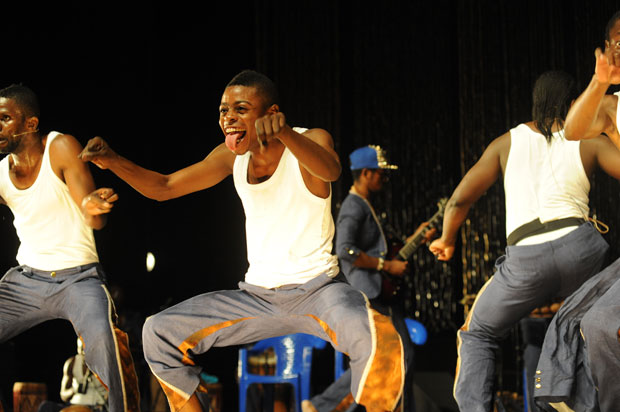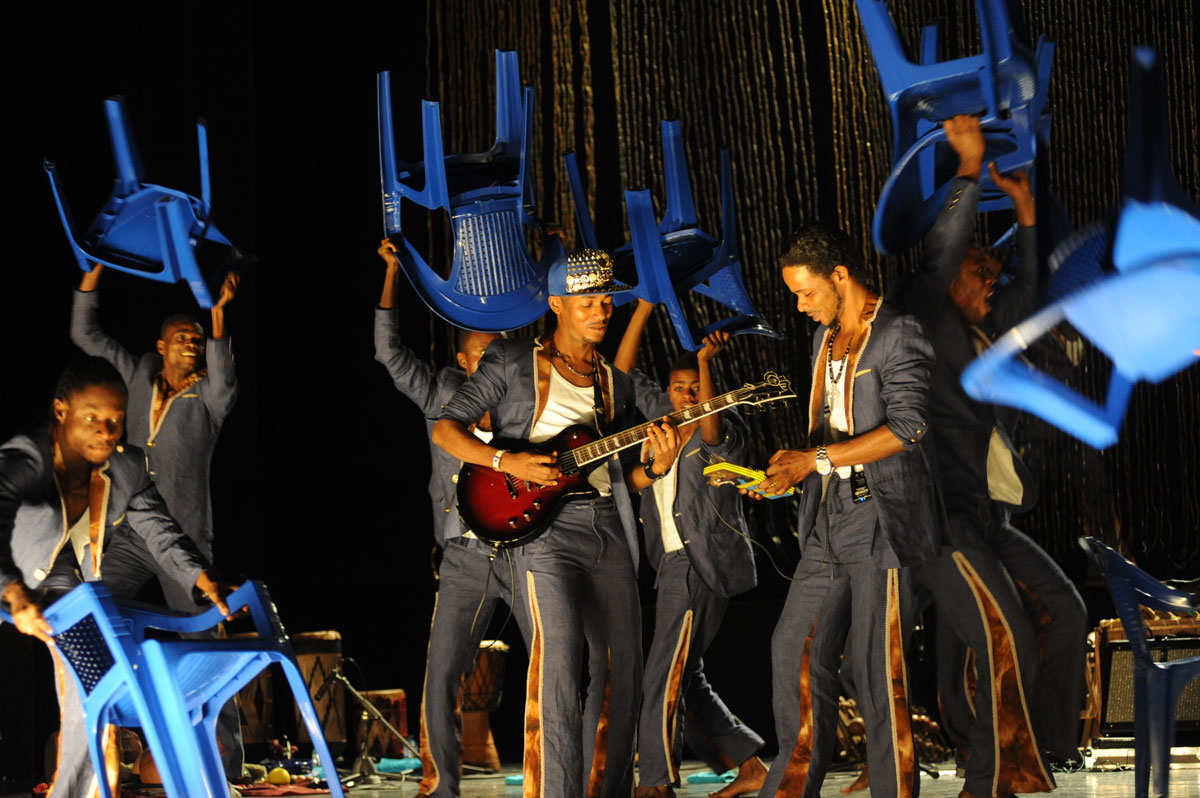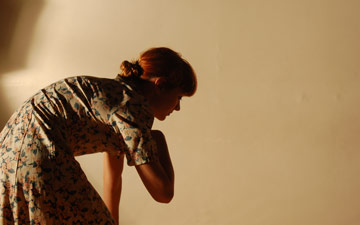
© Chris Van der Burght. (Click image for larger version)
Alain Platel with Fabrizio Cassol, Rodriguez Vangama & Serge Kakudji
Coup Fatal
London, Sadler’s Wells
4 June 2015
www.lesballetscdela.be
www.sadlerswells.com
Dance is certainly not the main draw for this extraordinary show; one of the more unique offerings at Sadler’s Wells in recent years (probably since previous pieces that maverick Belgian director and choreographer, Alain Platel, had a hand in making, such as Gardenia, a show all about aging drag artistes). Coup Fatal is an impossible-to-categorise music concert in which dance is but an energetic embellishment to the music in much the same way as dancers enliven a Kylie concert; only here it is the musicians that also do the dance.
It’s an all-male ensemble of thirteen singers and musicians, mostly from Kinshasa, each of whom can also dance. The centrepiece of this baker’s dozen is Serge Kakudji, the Congolese counter-tenor who first came to international prominence in Platel’s pitié (based on Bach’s St Matthew Passion), which began a long worldwide tour in 2008. From that venture emerged the concept for this show, which is the product of four collaborative inputs, with Platel and his regular composer – Fabrizio Cassol – joined in the spotlight by the on-stage talents of Kakudji and the music director and guitarist, Rodriguez Vangama.
Platel is remarkable among choreographers in that he is not – and never was – a dancer, his modus operandii being to orchestrate the performers’ own ideas into a form that is shaped by other elements of music, design and spectacle. Although this appears to be a project that has been taken on by his internationally-renowned company, les ballets C de la B, it is credited as a co-production by the four individuals, with Kakudji and Vangama taking the headline billing.
It is Vangama that gets the show under way in a long duet, playing his double-limbed Gibson guitar alongside Bouton Kalanda, a likembe player (if like me, you need to look it up, the likembe is a kind of piano for the thumbs, in which the sound of metal strips being plucked resonates against a hand-held wooden board). Their riff produces a slew of gorgeous sounds but nothing can prepare the audience for the sweet idiosyncrasy of Kakudji’s vocals; it is as if the voice of an angel emits from a heavyweight pugilist. The mix of baroque opera, adapted by Cassol from Vivaldi, Händel, Bach and company, and free-flowing Congolese pop, rock and jazz produces a compelling cocktail of highly unusual sound, above which rides the honeyed, contralto range of Kakudji’s unearthly voice.

© Chris Van der Burght. (Click image for larger version)
The men appear throughout the first part of the show like a “Jackson 13”, dressed in a uniform of grey 70s-style suits with huge flares, ruched piping and big gold stripes, exactly in the manner of an early Tamla Motown boy band. Gradually most of the jackets were discarded to reveal bright white vests underneath. Freddie Tsimba’s set was configured as for a music concert with a platform behind metal, beaded curtains (actually made from thousands of discarded gun cartridges, a silent reminder of the Congo’s violent recent history) and blue plastic garden chairs (apparently all the rage in Kinshasa), which were sat upon or used variously as props for movement.
Then, towards the end there is a rapid change of design ethos with each of the men dressed in garish, dandyish clothing – apparently in the style of “sapeurs”, a society of Congolese men who – in the early twentieth century – silently mocked their colonisers by deliberately exaggerating their European dress and mannerisms. The guitarist, Vangama, took this opportunity to dress like a white-suited-and-braided officer from Top Gun but adding a mink coat for extra effect. At the finale, works inspired by Bach and Händel were sandwiched between an energetic rendition of “Young Gifted and Black” as the zenith of a musical eclecticism that worked surprisingly well.
There was just one capsule of entertainment in which the dance takes priority, with a burly, topless guy dancing on the platform behind the gun-cartridge curtains, while two others perform athletic hip-hop moves on the main stage. The dancer on the platform performs with his back to us in a solo with fluid, undulating arms held wide to the side as if he is mimicking the dying swan. He is Kakudji’s voice portrayed in movement that is surprisingly sensitive for such a big guy.
The show was at least a half-hour too long. With an indicative time of 90 minutes, it actually ran for two hours without an interval. And, it could have done without some of the more overt “Carry-on” style macho, crotch-grabbing, “give-it-to-me-baby” sexism; buttock-wobbling twerking; and the intrusive attempts at audience interaction, which probably accounted for at least half that over-run. But, if these extras were required to enable Kakudji to recover his voice for the next extraordinary song, then it was a cross worth bearing.

















You must be logged in to post a comment.